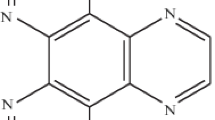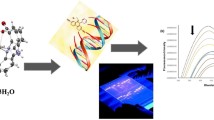Abstract
Novel homodinuclear Cu(II) (K1), heterodinuclear Cu(II)-Mn(II) (K2) and homotrinuclear Cu(II) (K3) complexes with a novel oxime-type ligand have been prepared and their nucleolytic activities on pCYTEXP were established by neutral agarose gel electrophoresis. The analyses of the cleavage products obtained electrophoretically indicate that although the examined complexes induces very similar conformational changes on supercoiled DNA by converting supercoiled form to nicked form than linear form in a sequential manner as the complex concentration or reaction period is increased, K3 is less effective than the two others. The oxime complexes were nucleolytically active at physiological pH values but the activities of K1 or K2 were diminished by increasing the pH of the reaction mixture. In contrast, K3 makes dominantly single strand nicking by producing nicked circles on DNA at almost all the applied pH values. Metal complex induced DNA cleavage was also tested for inhibition by various radical scavengers as superoxide dismutase (SOD), azide, thiourea and potassium iodide. The antioxidants inhibited the nucleolytic acitivities of the oxime complexes but SOD afforded no protection indicating that the nucleolytic mechanism involves of copper and/or manganese complex-mediated reactive oxygen species such as hydroxyl radicals being responsible for the oxidative DNA cleavage.
Similar content being viewed by others
References
Ahsan H, Hadi SM. 1998 Strand scission in DNA induced by curcumin in the presence of Cu(II). Cancer Lett 124, 23-30.
Asad SF, Singh S, Ahmad A, Hadi SM. 1999 Billirubin-Cu(II) complex degrades DNA. Biochim Biophys Acta 1428, 201-208.
Athar F, Arjmand F, Tabassum S. 2001 New asymmetric N2S2 macrocycles, their metal chelates and the photokinetics of DNA-complex interaction. Transition Met Chem 26, 426-429.
Barton JK. 1986 Metals and DNA: Molecular left-handed complements. Science 233, 727-733.
Belev TN, Singh M, McCarthy JEG. 1991 A fully modular vector system for the optimization of gene expression in Eschericia coli. Plasmid 26, 147-150.
Borah S, Melvin MS, Lindquist N, Manderville RA. 1998 Copper-mediated nuclease activity of a tambjamine alkaloid. J Am Chem Soc 120, 4557-4562.
Corey DR, Pei D, Schultz PG. 1990 Generation of a catalytic sequence-specific hybrid DNase. Biochemistry 28, 8277-8286.
Criado JJ, Garcia-Moreno MC, Macias RR, Marin JJG, Medarde M, Rodriguez-Fernandez E. 1999 Synthesis and characterization of sodium cis-dichlorochenodeoxycholylglycinato (O,N) platinum(II)-cytostatic activity. Biometals 12, 281-288.
Dervan PB. 1992 Reagents for the site-specific cleavage of megabase DNA. Nature 359, 87-88.
Detmer CA, Pamatong FV, Bocarsly JR. 1996 Nonrandom double strand cleavage of DNA by a monofunctional metal complex: mechanistic studies. Inorg Chem 35, 6292-6298.
Dizdaroglu M. 1992 Oxidative damage to DNA in mammalian chromatin. Mutat Res 275, 331-342.
Dülger S, Saglam N, Beldüz AO, Güner S, Karaböcek S. 2000 DNA cleavage by homo-and heterotetranuclear Cu(II) and Mn(II) complexes with tetrathioether-tetrathiol moiety. Biometals 13, 261-265.
Gonzalez VM, Amo-Ochoa P, Perez JM, Fuertes MA, Masaguer JR, Navarro-Ranninger C, Alonso C. 1996 Synthesis, characterization and DNA modification induced by a novel Pt-berenil compound with cytotoxic activity. J Inorg Biochem 63, 57-68.
Gravert DJ, Griffin JH. 1993 Specific DNA cleavage mediated by [salenMn(III)]+. J Org Chem 58, 820-822.
Groves JT, Farrell TP. 1989 DNA cleavage by a metal chelating tricationic porphyrin. J Am Chem Soc 111, 4998-5000.
Halliwell B, Aruoma OI. 1991 DNA damage by oxygen-derived species: its mechanism and measurement in mammalian systems. FEBS Lett 281, 9-19.
Halliwell B. 1995 Antioxidants: Elixirs of life or tonics for tired sheep? Biochemist 17, 3-6.
Hertzberg RP, Dervan PB. 1982 Cleavage of double helical DNA by methidium propyl-EDTA-iron(II). J Am Chem Soc 104, 313-315.
Imlay JA, Linn S. 1988 DNA damage and oxygen radical toxicity. Science 240, 1302-1309.
Liu C, Zhou J, Li Q, Wang L, Liao Z, Xu H. 1999 DNA damage by copper(II) complexes: Coordination-structural dependence of reactivities. J Inorg Biochem 75, 233-240.
Mandal SS, Kumar NV, Varshney U, Bhattacharya S. 1996 Metalion-dependent oxidative DNA cleavage by transition metal complexes of a new water soluble salen derivative. J Inorg Biochem 63, 265-272.
McLachlan GA, Muller, JG, Rokita, SE, Burrows CJ. 1996 Metal-mediated oxidation of guanines in DNA and RNA: a comparison of cobalt(II), nickel(II) and copper(II) complexes. Inorg Chim Acta 251, 193-199.
Papavassiliou AG. 1995 Chemical nucleases as probes for studying DNA-protein interactions. Biochem J 305, 345-357.
Peti W, Pieper T, Sommer M, Keppler SB, Giester G. 1999 Synthesis of tumor-inhibiting complex salts containing the anion transtetrachlorobis(indazole)ruthenate(III) and crystal structure of the tetraphenylphosphonium salt. Eur J Inorg Chem, 1551-1555.
Pope LE, Sigman DS. 1984 Secondary structure specificity of the nuclease activity of the 1,10-phenathroline-copper complexes. Proc Natl Acad Sci USA 81, 3-7.
Pratviel G, Duarte V, Bernadou J, Meunier B. 1993 Nonenzymatic cleavage and ligation of DNA at a three A.T base pair site: a two step pseudohydrolysis of DNA. J Am Chem Soc 115, 7939-7943.
Pryor WA. 1988 Why is the hydroxyl radical the only radical that commonly binds to DNA? Hypothesis: It has a rare combination of high electrophilicity, high thermo-chemico reactivity, and a mode of production that can occur near DNA. Free Rad Biol Med 4 219-223.
Reddy KH, Reddy PS, Babu PR. 2000a Nuclease activity of 2-substituted heteroaromatic thiosemicarbazone and semicarbazone copper(II) complexes. Transition Met Chem 25, 154-160.
Reddy KH, Reddy PS, Babu PR. 2000b Nuclease activity of mixed ligand complexes of copper(II) with heteroaromatic derivatives and picoline. Transition Met Chem 25, 505-510.
Ross SA, Pittie M, Meunier B. 1999 Synthesis of two acridine conjugates of the bis(phenanthroline) ligand 'Clip-Phen' and evaluation of the nuclease activity of the corresponding copper complexes. Eur J Inorg Chem 557-563.
Routier S, Bernier J-L, Waring MJ, Colson P, Houssier C, Bailly C. 1996 Synthesis of a functionalized salen-copper complex and its interaction with DNA. J Org Chem 61, 2326-2331.
Sargeson AM. 1996 The potential for the cage complexes in biology. Coord Chem Rev 151, 89-114.
Sato K, Chikira M, Fujii Y, Komatsu A. 1994 Stereospecific binding of chemically modified salen-type Schiff base complexes of copper(II) with DNA. J Chem Soc Chem Commun 5, 625-626.
Serbest K, Karaböcek S, De?irmencio?lu I, Güner S, Kormali F. 2001 Mono-, di-and trinuclear copper(II) dioxime complexes; 3-{2-[2-(2-hydroxyimino-1-methylpropylideneamino)ethylimino}butan-2-one oxime. Transition Met Chem 26, 375-379.
Sherman SE, Lippard SJ. 1987 Structural aspects of platinum anticancer drug interactions with DNA. Chem Rev 87, 1153-1181.
Shi X, Dalal NS, Kasprzak KS. 1993 Generation of free radicals from hydrogen peroxide and lipid peroxides in the presence of Cr(III). Arch Biochem Biophys 302, 294-299.
Sigman DS, Chen CB. 1990 Chemical nucleases: new reagents in molecular biology. Ann Rev Biochem 59, 207-236.
Sigman DS, Graham DR, D'Aurura V, Stern AM. 1979 Oxygen-dependent cleavage of DNA by the 1,10-phenanthroline-cuprous complex. J Biol Chem 254, 12269-12272.
Sigman DS, Mazumender A, Perrin DM. 1993 Chemical nucleases. Chem Rev 93, 2295-2316.
Sigman DS. 1986 Nuclease activity of 1,10-phenanthroline-copper ion. Acc Chem Res 19, 180-186.
Travers AA. 1993 In: DNA-Protein Interactions. London: Chapman and Hall.
Tsou T-C, Yang J-L. 1996 Formation of reactive oxygen species and DNA strand breakage during interaction of chromium(III) and hydrogen peroxide in vitro: Evidence for a chromium(III)-mediated Fenton-like reaction. Chem-Biol Interact 102, 133-153.
Veal, JM, Rill RL. 1988 Sequence specificity of DNA cleavage by bis(1,10-phenathroline)copper(I). Biochemistry 27, 1822-1827.
Woodson SA, Muller JG, Burrows CJ, Rokita SE. 1993 A primer extension assay for modification of guanine by Ni(II) complexes. Nucleic Acid Res 21, 5524-5525.
Author information
Authors and Affiliations
Rights and permissions
About this article
Cite this article
Saglam, N., Colak, A., Serbest, K. et al. Oxidative cleavage of DNA by homo- and heteronuclear Cu(II)-Mn(II) complexes of an oxime-type ligand. Biometals 15, 357–365 (2002). https://doi.org/10.1023/A:1020228723299
Issue Date:
DOI: https://doi.org/10.1023/A:1020228723299




